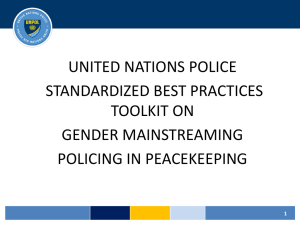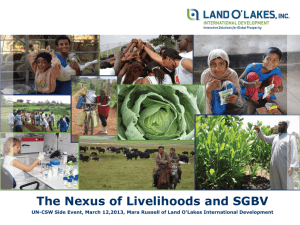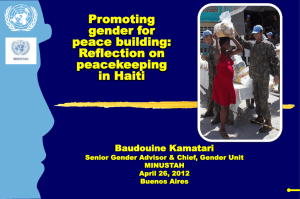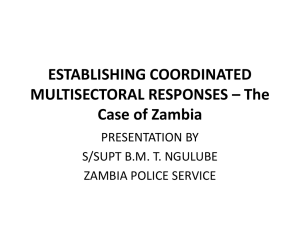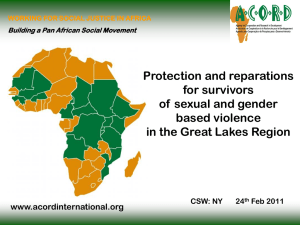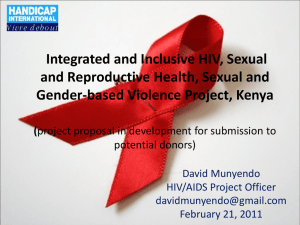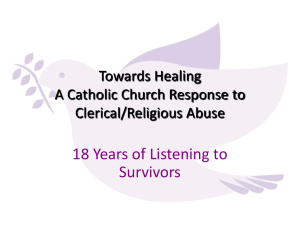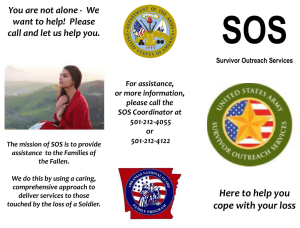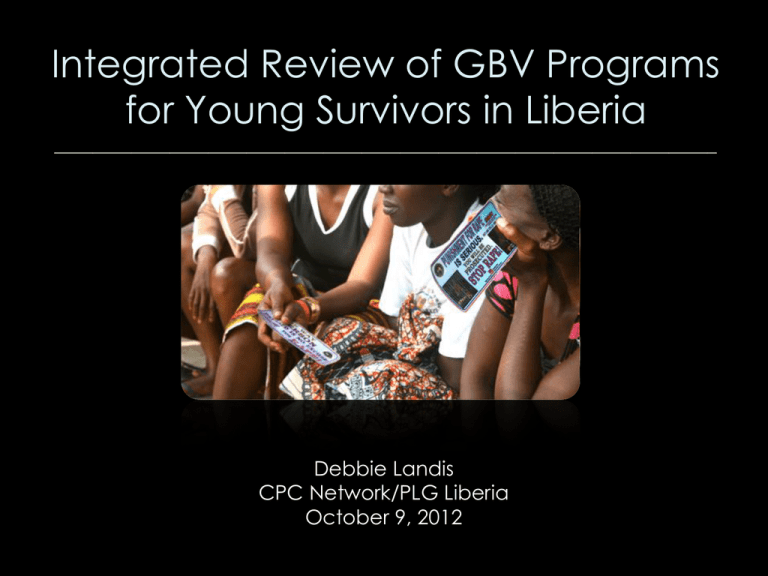
Integrated Review of GBV Programs
for Young Survivors in Liberia
_____________________________________________________________________
Debbie Landis
CPC Network/PLG Liberia
October 9, 2012
Background/Context:
______________________________________________________________________
• Sexual violence was
systematic and widespread
during the conflict
•
Ex. 2004 WHO assessment in IDP camps
found almost 80% of women surveyed
experienced sexual violence during war
• Rates of rape and sexual
assault continue to be high
• The majority of reported
cases are children (under 18)
•
In 2011, the average age of rape
survivors was 16, and almost 50% of total
cases between the ages of 5-14
(Source: MoGD)
National Structure- part I
______________________________________________________________________
•
Rape Amendment Act of 2006
•
GBV National Action Plan & Joint
UN/GoL SGBV Program:
– 5 “pillars”:
• 1) psychosocial
• 2) health
• 3) legal/justice
• 4) protection
• 5) coordination
•
GBV Taskforce
–
•
National and County Taskforces
GBV Unit and the Ministry of
Gender and Development
(MoGD)
National Structure- part II
______________________________________________________________________
•
Women and Children’s
Protection Section (WACPS)
–
–
•
SGBV Crimes Unit
–
•
In Monrovia; prosecution of cases as
well as services to survivors
Criminal Court “E”
–
•
Specialized training on SGBV
HQ in Monrovia and other depots at
the county level
“in camera” hearings
Standard Operating Procedures
(SOPs) and Referral Pathway
–
Adapted at the county level
Study Overview:
___________________________________________________________________
•
•
•
Timeframe:
– May-August 2012
Location:
– Monrovia, Liberia
Methods:
– Key informant interviews
(40 individuals)
– Structured document
review (279 documents)
– Survivor Interviews (15
female survivors)
– Observations of program
activities
Research Questions:
_____________________________________________________________________
1.
How is the formal
system responding to
the needs of children
affected by sexual
and gender-based
violence (SGBV)?
2.
What promising
practices are evident
in the prevention and
response initiatives of
key actors?
Criteria for “promising practice”:
___________________________________________________________________
1.
Evaluations
demonstrating
measureable
change
2.
Expert consensus
3.
Survivor perceptions
Criteria #1: Evaluations Demonstrating
Measureable Change
_______________________________________________________________________
Documents Submitted:
Number of
Documents:
Number of
Evaluations:
279
12
Number
Documenting
Measurable
Change:
Number
Documenting
a Reduction in
Violence:
5
0
Program Types in which “Measurable
Change” was found:
________________________________________________________________
Program Type
Examples of Change
Program 1: Training on SGBV
and reproductive health,
livelihoods
-% who reported increased access to RH
services
-% who reported increased economic
opportunities
Program 2: SEA awareness
campaign
-% who reported awareness of campaign
-% who reported awareness of SGBV
Program 3: Small enterprise
development and SGBV
training
-% who are able to meet basic needs as a
result of program
-% who reported awareness about SGBV
Program 4: Sensitization on
SGBV, livelihoods, support to
health centers, male
engagement
-% who reported increased knowledge
about SGBV
-% of girls who reported advancement in
education
Program 5: Sensitization on
SGBV and case management
-Comparison group of participants and nonparticipants
-% of respondents who reported increased
knowledge and awareness of SGBV
Criteria #2: Expert Consensus
____________________________________________________________________
Key Informant Current Areas of Programming:
Program Type
# KI who reported:
Community-based Training and Sensitization
22
School-based Training and Sensitization
14
Case Management for Survivors
12
Economic Empowerment/Livelihoods
9
Education/Literacy/Life Skills
9
Promotion of Community-based Protection Groups
7
Children's Groups/Clubs (outside of school)
7
Counseling and Psychosocial Support
7
Men's Groups/Male Engagement
6
Training and Capacity Building for the Police
6
Medical Services
Legal Support
6
6
Women's Groups
Other
5
4
Program Area 1: Training and Sensitization
_________________________________________________________________________________
• 22 KIs reported
involvement in
community-based
training; 13 in schoolbased training
• Training and
sensitization have
increased rates of
reporting (23 KIs)
"But now with this extensive education,
information, communication--and dissemination
of information and materials on rape, it's a
gradual change. You can see the change
because they will report it. It never used to be
reported.”
~ Key Informant, local NGO
• Additional training is
needed in order to
address cultural
perceptions that
contribute to SGBV and
to raise awareness of
law (28 KIs)
Program Area 2: Community-based
Groups
_______________________________________________________________________________
• 17 KIs reported supporting
community-based groups
(CWCs, women’s groups,
children’s groups, men’s
groups, etc.)
• There is a need to work
with local leaders and
build up communitybased protective
structures (30 KIs)
• Male engagement is an
important strategy to
addressing SGBV (13 KIs)
“That is an important lesson, that the availability of
structures and the strengthening of structures at
local level will enhance reductions [of violence] or
enhance services provided to SGBV survivors.”
~ Key Informant, international NGO
Program Area 3: Direct Support to
Survivors
_______________________________________________________________________________
“So as they [the survivor] go through this
process--so it's just actually facilitating,
counseling and making sure that the victim is
cared for and the writing is done. And, also, the
perpetrator is actually accountable..."
~ Key Informant, local NGO
•
12 KIs reported involvement in case
management; 7 psychosocial
support; 6 medical services; 6 legal
services
•
Safe homes are a strong source of
protection and psychosocial
support (17 KIs)
•
The referral pathway is welldeveloped (28 KIs), although
access to services is significantly
greater in Monrovia (23 KIs)
•
WACPS is child-friendly and
effective (22 KIs); SGBV Crimes Unit
effective (18)
•
Family mediation and follow up
with police/courts can increase
access to justice (8 KIs)
Program Area 4: Empowerment and Skillbuilding
_______________________________________________________________________________
•
11 KIs reported involvement
in empowerment/skillbuilding activities (life skills,
livelihoods, business
development, literacy, etc.)
for women and/or girls
•
Results reported included
increase in participants going
to school, starting businesses,
etc.
•
Often integrated with SGBV
sensitization
•
Described as both
prevention and response
initiatives
“And then even with these vocational programs,
when you come together, your friend is there. You
know, you are chatting and going on about the
daily life and all-, in a vocational training area. It
helps to minimize trauma…. And it lets you know
that you're not the only person that has been
victimized."
~ Key Informant, local NGO
Challenges:
______________________________________________________________________
• “Compromising cases” (37 KIs):
–
–
Family/community and police/court levels
“harsh” penalty of rape law deemed a
factor by some at community level
• Cultural perceptions (22 KIs):
–
–
–
Only rape if survivor was a virgin
Acceptance of early marriage/early
sexual activity
Acceptance of “sex for money/goods”
• Inefficiencies with the justice
system (21 KIs):
–
“The maximum penalty is life in prison. So people tell
the girl, ‘You know this guy is going to be locked up
for life. It’ll be a problem in the community. You don’t
need to do that. Why should you do that.’ They look
at it as something small. They don’t look at it as
something which is damaging that person. They will
tell you, ‘You are not the first. It has happened. Just
move forward.’”
~Key Informant, international NGO
Insufficient evidence, long delays, cases
dismissed on procedural grounds, juror
qualifications, lack of “Criminal Court E” in
counties, low prosecution rates, impunity,
etc.
• Limited access in rural areas
(21 KIs):
–
–
Expressed with regard to all sectors
(health, legal, police, psychosocial, etc.)
Transportation in rural areas a particular
challenge
Criteria 3: Survivor Perceptions
_________________________________________________________________________
•
Interviews with 15 female survivors
•
Reported receiving:
– Medical care
– Psychosocial support
– Access to police and court
•
Reported referrals to current
services from WACPS or SGBV
Crimes Unit
“They help us feel good and forget
about the past.”
•
Reported satisfaction with current
services
~Female survivor, age 16
•
Limited finances/resource
constraints reported as challenge
(less staff, less activities, etc.)
Discussion/Implications:
___________________________________________________________________
•
Need for more rigorous evaluations to
expand the evidence base
•
Training and sensitization have made an
impact, but more work is needed
•
The legal framework is strong, but significant
capacity building is needed in the justice
sector
•
The referral pathway has put essential
services in place, but access is limited in rural
locations
•
Promoting community-based structures is
essential for program success
•
Multi-sectorial programming is needed
•
Further development of “child-focused”
guidelines

